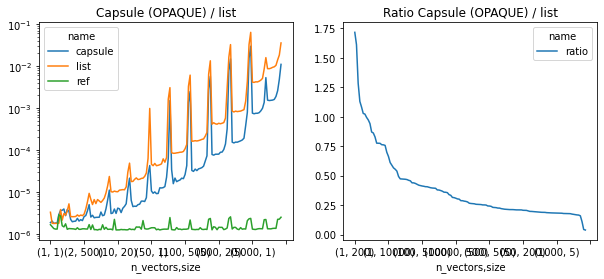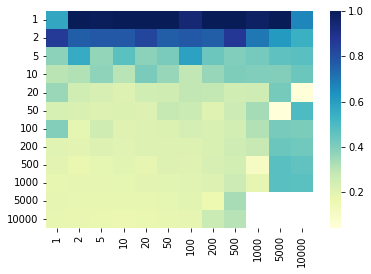Use of PYBIND11_MAKE_OPAQUE¶
Links: notebook, html, PDF, python, slides, GitHub
pybind11 automatically converts
std::vector into python list. That’s convenient but not necessarily
efficient depending on how it is used after that.
PYBIND11_MAKE_OPAQUE
is used to create a
capsule to hold a
pointer on the C++ object.
from jyquickhelper import add_notebook_menu
add_notebook_menu()
%matplotlib inline
Two identical classes¶
Both of then creates random vectors equivalent to
std::vector<Tensor>, and Tensor ~ std::vector<float>. The first
one returns a capsule due
PYBIND11_MAKE_OPAQUE(std::vector<OneTensorFloat>) inserted into the
C++ code. The other one is returning a list.
from cpyquickhelper.examples.vector_container_python import (
RandomTensorVectorFloat, RandomTensorVectorFloat2)
rnd = RandomTensorVectorFloat(10, 10)
result = rnd.get_tensor_vector()
print(result)
<cpyquickhelper.examples.vector_container_python.OneTensorVector object at 0x000002B144FB5470>
result_ref = rnd.get_tensor_vector_ref()
print(result_ref)
<cpyquickhelper.examples.vector_container_python.TensorVectorConstReferencePointer object at 0x000002B13BB8DD70>
rnd2 = RandomTensorVectorFloat2(10, 10)
result2 = rnd2.get_tensor_vector()
print(result2)
[<cpyquickhelper.examples.vector_container_python.OneTensor2 object at 0x000002B144BC4330>, <cpyquickhelper.examples.vector_container_python.OneTensor2 object at 0x000002B144BC2BF0>, <cpyquickhelper.examples.vector_container_python.OneTensor2 object at 0x000002B144BC2E30>, <cpyquickhelper.examples.vector_container_python.OneTensor2 object at 0x000002B144BC2C30>, <cpyquickhelper.examples.vector_container_python.OneTensor2 object at 0x000002B144BC2FB0>, <cpyquickhelper.examples.vector_container_python.OneTensor2 object at 0x000002B144BC2970>, <cpyquickhelper.examples.vector_container_python.OneTensor2 object at 0x000002B144BC26F0>, <cpyquickhelper.examples.vector_container_python.OneTensor2 object at 0x000002B144BC22B0>, <cpyquickhelper.examples.vector_container_python.OneTensor2 object at 0x000002B144BC21B0>, <cpyquickhelper.examples.vector_container_python.OneTensor2 object at 0x000002B144BC20F0>]
result2_ref = rnd2.get_tensor_vector_ref()
print(result2_ref)
<cpyquickhelper.examples.vector_container_python.TensorVectorConstReferencePointer2 object at 0x000002B144EE0C30>
%timeit rnd.get_tensor_vector()
3.13 µs ± 60.6 ns per loop (mean ± std. dev. of 7 runs, 100,000 loops each)
%timeit rnd.get_tensor_vector_ref()
1.21 µs ± 38.4 ns per loop (mean ± std. dev. of 7 runs, 1,000,000 loops each)
%timeit rnd2.get_tensor_vector()
10.4 µs ± 138 ns per loop (mean ± std. dev. of 7 runs, 100,000 loops each)
%timeit rnd2.get_tensor_vector_ref()
1.19 µs ± 18.1 ns per loop (mean ± std. dev. of 7 runs, 1,000,000 loops each)
Scenarii¶
Three possibilities:
list:
std::vector<Tensor>is converted into a list of copied Tensorscapsule:
std::vector<Tensor>is converted into a capsule on a copiedstd::vector<Tensor>, the capsule still holds the pointer and is responsible to the deletion.ref:
std::vector<Tensor>is just return as a pointer. The cost of getting the pointer does not depend on the content size. It is somehow the low limit.
Plots¶
import itertools
from cpyquickhelper.numbers.speed_measure import measure_time
from tqdm import tqdm
import pandas
data = []
sizes = [1, 2, 5, 10, 20, 50, 100, 200, 500, 1000, 5000, 10000]
sizes = list(itertools.product(sizes, sizes))
for i, j in tqdm(sizes):
if j >= 1000:
if i > 1000:
continue
if i * j >= 1e6:
repeat, number = 3, 3
else:
repeat, number = 10, 10
rnd = RandomTensorVectorFloat(i, j)
obs = measure_time(lambda: rnd.get_tensor_vector(), repeat=repeat, number=number, div_by_number=True)
obs['name'] = 'capsule'
obs['n_vectors'] = i
obs['size'] = j
data.append(obs)
rnd2 = RandomTensorVectorFloat2(i, j)
obs = measure_time(lambda: rnd2.get_tensor_vector(), repeat=repeat, number=number, div_by_number=True)
obs['name'] = 'list'
obs['n_vectors'] = i
obs['size'] = j
data.append(obs)
obs = measure_time(lambda: rnd2.get_tensor_vector_ref(), repeat=repeat, number=number, div_by_number=True)
obs['name'] = 'ref'
obs['n_vectors'] = i
obs['size'] = j
data.append(obs)
df = pandas.DataFrame(data)
df.tail()
100%|████████████████████████████████████████████████████████████████████████████████| 144/144 [00:19<00:00, 7.43it/s]
| average | deviation | min_exec | max_exec | repeat | number | ttime | context_size | name | n_vectors | size | |
|---|---|---|---|---|---|---|---|---|---|---|---|
| 409 | 0.018321 | 0.000367 | 0.018026 | 0.018838 | 3 | 3 | 0.054962 | 64 | list | 10000 | 200 |
| 410 | 0.000002 | 0.000001 | 0.000001 | 0.000004 | 3 | 3 | 0.000007 | 64 | ref | 10000 | 200 |
| 411 | 0.010974 | 0.000492 | 0.010512 | 0.011656 | 3 | 3 | 0.032923 | 64 | capsule | 10000 | 500 |
| 412 | 0.035484 | 0.000900 | 0.034286 | 0.036456 | 3 | 3 | 0.106451 | 64 | list | 10000 | 500 |
| 413 | 0.000003 | 0.000002 | 0.000001 | 0.000005 | 3 | 3 | 0.000008 | 64 | ref | 10000 | 500 |
piv = pandas.pivot_table(df, index=['n_vectors', 'size'], columns=['name'], values='average')
piv['ratio'] = piv['capsule'] / piv['list']
piv.tail()
| name | capsule | list | ref | ratio | |
|---|---|---|---|---|---|
| n_vectors | size | ||||
| 10000 | 20 | 0.001611 | 0.009616 | 0.000001 | 0.167512 |
| 50 | 0.001892 | 0.010399 | 0.000001 | 0.181907 | |
| 100 | 0.002597 | 0.014054 | 0.000002 | 0.184789 | |
| 200 | 0.004847 | 0.018321 | 0.000002 | 0.264565 | |
| 500 | 0.010974 | 0.035484 | 0.000003 | 0.309278 |
import matplotlib.pyplot as plt
fig, ax = plt.subplots(1, 2, figsize=(10, 4))
piv[['capsule', 'list', 'ref']].plot(logy=True, ax=ax[0], title='Capsule (OPAQUE) / list')
piv.sort_values('ratio', ascending=False)[['ratio']].plot(ax=ax[1], title='Ratio Capsule (OPAQUE) / list');

flat = piv.reset_index(drop=False)[['n_vectors', 'size', 'ratio']]
flat_piv = flat.pivot('n_vectors', 'size', 'ratio')
flat_piv
| size | 1 | 2 | 5 | 10 | 20 | 50 | 100 | 200 | 500 | 1000 | 5000 | 10000 |
|---|---|---|---|---|---|---|---|---|---|---|---|---|
| n_vectors | ||||||||||||
| 1 | 0.566917 | 1.130723 | 0.995022 | 1.023320 | 1.028793 | 1.612390 | 0.943035 | 1.717130 | 1.284653 | 0.973898 | 1.083473 | 0.663566 |
| 2 | 0.862783 | 0.757669 | 0.775862 | 0.775123 | 0.829735 | 0.763393 | 0.776532 | 0.762319 | 0.871343 | 0.699622 | 0.612026 | 0.539308 |
| 5 | 0.379608 | 0.555293 | 0.368967 | 0.470159 | 0.378897 | 0.410572 | 0.589214 | 0.434686 | 0.395905 | 0.419958 | 0.461235 | 0.473515 |
| 10 | 0.301479 | 0.316046 | 0.374528 | 0.303198 | 0.407169 | 0.359681 | 0.288451 | 0.360526 | 0.402298 | 0.398315 | 0.393545 | 0.439519 |
| 20 | 0.356484 | 0.251247 | 0.230067 | 0.210293 | 0.252366 | 0.255456 | 0.288205 | 0.284486 | 0.252392 | 0.257864 | 0.416393 | 0.043764 |
| 50 | 0.231620 | 0.220888 | 0.210009 | 0.216061 | 0.214163 | 0.282138 | 0.266862 | 0.206823 | 0.263674 | 0.339590 | 0.039424 | 0.493669 |
| 100 | 0.394659 | 0.189204 | 0.256503 | 0.206615 | 0.214958 | 0.218592 | 0.240267 | 0.225569 | 0.243605 | 0.314168 | 0.412960 | 0.406809 |
| 200 | 0.201795 | 0.189723 | 0.211110 | 0.197427 | 0.212577 | 0.212658 | 0.212798 | 0.225500 | 0.257274 | 0.277588 | 0.439891 | 0.427631 |
| 500 | 0.189678 | 0.169699 | 0.188959 | 0.193446 | 0.184101 | 0.209909 | 0.205913 | 0.229271 | 0.243023 | 0.110660 | 0.472577 | 0.456907 |
| 1000 | 0.181940 | 0.183248 | 0.183335 | 0.186856 | 0.191277 | 0.195801 | 0.197123 | 0.209983 | 0.262004 | 0.184530 | 0.471995 | 0.467629 |
| 5000 | 0.183440 | 0.179145 | 0.178354 | 0.179633 | 0.178630 | 0.185844 | 0.194558 | 0.160261 | 0.334000 | NaN | NaN | NaN |
| 10000 | 0.178259 | 0.174690 | 0.172229 | 0.166271 | 0.167512 | 0.181907 | 0.184789 | 0.264565 | 0.309278 | NaN | NaN | NaN |
import numpy
import seaborn
seaborn.heatmap(numpy.minimum(flat_piv.values, 1), cmap="YlGnBu",
xticklabels=list(flat_piv.index), yticklabels=list(flat_piv.columns));

